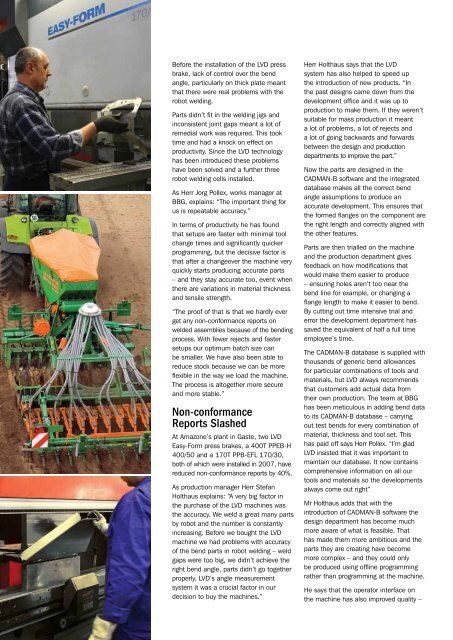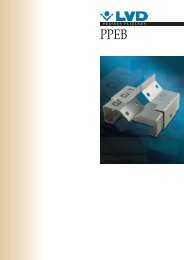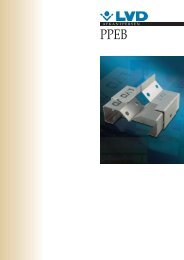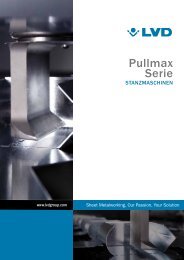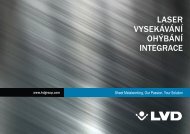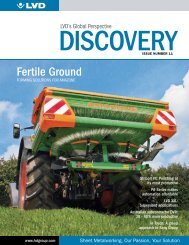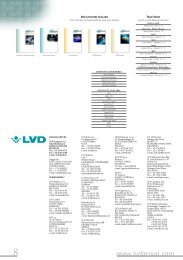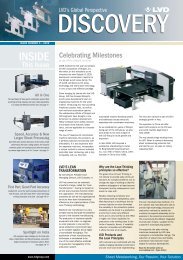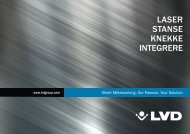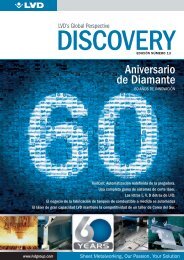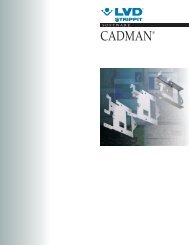Discovery Newsletter 11 - English International - LVD
Discovery Newsletter 11 - English International - LVD
Discovery Newsletter 11 - English International - LVD
You also want an ePaper? Increase the reach of your titles
YUMPU automatically turns print PDFs into web optimized ePapers that Google loves.
Before the installation of the <strong>LVD</strong> press<br />
brake, lack of control over the bend<br />
angle, particularly on thick plate meant<br />
that there were real problems with the<br />
robot welding.<br />
Parts didn’t fit in the welding jigs and<br />
inconsistent joint gaps meant a lot of<br />
remedial work was required. This took<br />
time and had a knock on effect on<br />
productivity. Since the <strong>LVD</strong> technology<br />
has been introduced these problems<br />
have been solved and a further three<br />
robot welding cells installed.<br />
As Herr Jorg Pollex, works manager at<br />
BBG, explains: “The important thing for<br />
us is repeatable accuracy.”<br />
In terms of productivity he has found<br />
that setups are faster with minimal tool<br />
change times and significantly quicker<br />
programming, but the decisive factor is<br />
that after a changeover the machine very<br />
quickly starts producing accurate parts<br />
– and they stay accurate too, event when<br />
there are variations in material thickness<br />
and tensile strength.<br />
“The proof of that is that we hardly ever<br />
get any non-conformance reports on<br />
welded assemblies because of the bending<br />
process. With fewer rejects and faster<br />
setups our optimum batch size can<br />
be smaller. We have also been able to<br />
reduce stock because we can be more<br />
flexible in the way we load the machine.<br />
The process is altogether more secure<br />
and more stable.”<br />
Non-conformance<br />
Reports Slashed<br />
At Amazone’s plant in Gaste, two <strong>LVD</strong><br />
Easy-Form press brakes, a 400T PPEB-H<br />
400/50 and a 170T PPB-EFL 170/30,<br />
both of which were installed in 2007, have<br />
reduced non-conformance reports by 40%.<br />
As production manager Herr Stefan<br />
Holthaus explains: “A very big factor in<br />
the purchase of the <strong>LVD</strong> machines was<br />
the accuracy. We weld a great many parts<br />
by robot and the number is constantly<br />
increasing. Before we bought the <strong>LVD</strong><br />
machine we had problems with accuracy<br />
of the bend parts in robot welding – weld<br />
gaps were too big, we didn’t achieve the<br />
right bend angle, parts didn’t go together<br />
properly. <strong>LVD</strong>’s angle measurement<br />
system it was a crucial factor in our<br />
decision to buy the machines.”<br />
Herr Holthaus says that the <strong>LVD</strong><br />
system has also helped to speed up<br />
the introduction of new products. “In<br />
the past designs came down from the<br />
development office and it was up to<br />
production to make them. If they weren’t<br />
suitable for mass production it meant<br />
a lot of problems, a lot of rejects and<br />
a lot of going backwards and forwards<br />
between the design and production<br />
departments to improve the part.”<br />
Now the parts are designed in the<br />
CADMAN-B software and the integrated<br />
database makes all the correct bend<br />
angle assumptions to produce an<br />
accurate development. This ensures that<br />
the formed flanges on the component are<br />
the right length and correctly aligned with<br />
the other features.<br />
Parts are then trialled on the machine<br />
and the production department gives<br />
feedback on how modifications that<br />
would make them easier to produce<br />
– ensuring holes aren’t too near the<br />
bend line for example, or changing a<br />
flange length to make it easier to bend.<br />
By cutting out time intensive trial and<br />
error the development department has<br />
saved the equivalent of half a full time<br />
employee’s time.<br />
The CADMAN-B database is supplied with<br />
thousands of generic bend allowances<br />
for particular combinations of tools and<br />
materials, but <strong>LVD</strong> always recommends<br />
that customers add actual data from<br />
their own production. The team at BBG<br />
has been meticulous in adding bend data<br />
to its CADMAN-B database – carrying<br />
out test bends for every combination of<br />
material, thickness and tool set. This<br />
has paid off says Herr Pollex. “I’m glad<br />
<strong>LVD</strong> insisted that it was important to<br />
maintain our database. It now contains<br />
comprehensive information on all our<br />
tools and materials so the developments<br />
always come out right”<br />
Mr Holthaus adds that with the<br />
introduction of CADMAN-B software the<br />
design department has become much<br />
more aware of what is feasible. That<br />
has made them more ambitious and the<br />
parts they are creating have become<br />
more complex – and they could only<br />
be produced using offline programming<br />
rather than programming at the machine.<br />
He says that the operator interface on<br />
the machine has also improved quality –<br />
<strong>LVD</strong> <strong>Discovery</strong> | 10


